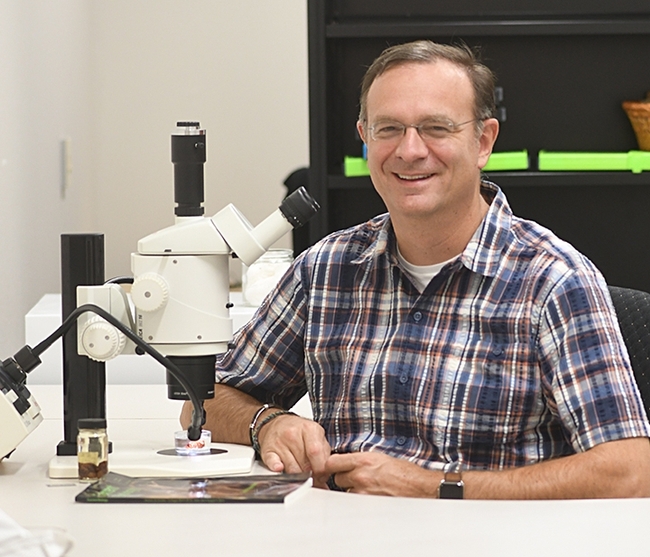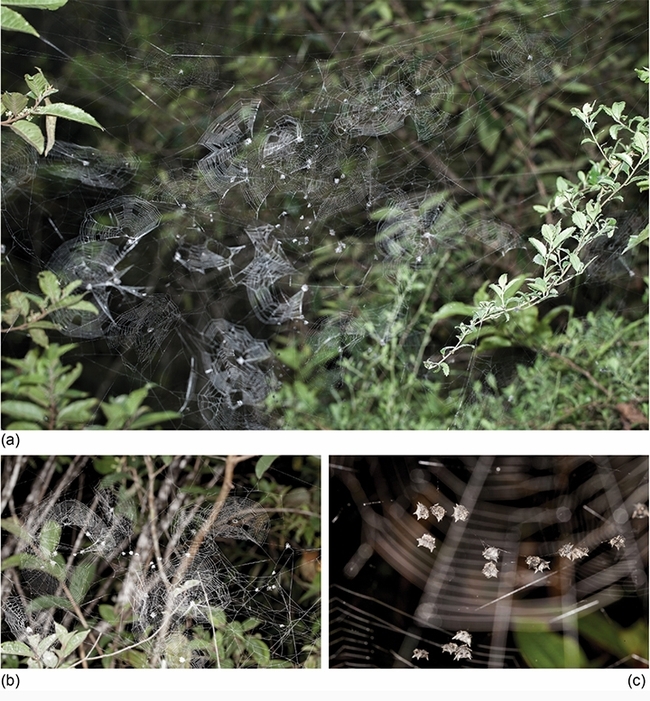
In lekking, certain species of males in the animal world, including black grouse, peacock and owl parrots, congregate in a courtship ritual to entice females to mate with them. This is unusual because spiders are notoriously solitary and cannibalistic.
Two UC Davis spider experts played a key role in analyzing the genetics of this spider. The new species is an orb weaver named Isoxya manangona. Its species name is derived from the Malagasy verb meaning to "gather" or "aggregate."
Jason Bond, the Evert and Marion Schlinger Endowed Chair in the UC Davis Department of Entomology and Nematology and project scientist James Starrett headed the genetic analysis. The research paper was recently published in the journal, Insect Systematics and Diversity.
“This paper is significant in a number of respects including the discovery of a new species of orb web-weaving spider that is social; most spiders are solitary predators that are cannibalistic,” said Bond, who doubles as associate dean, UC Davis College of Agricultural and Environmental Sciences. “Although additional behavioral studies are needed to confirm, what is particularly interesting about this paper is that we report what is likely the first known observation of lekking behavior in spiders.”

Ingi Agnarsson, a professor of zoology at the University of Iceland and the Smithsonian Institution, Washington, D.C., headed the international team of researchers.
While looking for bark spiders in the rainforests of Andasibe-Mantadia National Park, the scientists observed large colonies of interconnected webs, built by what they later determined to be a new species.
In examining the webs, the researchers noticed multiple males gathering close together, sometimes touching, in a central, nonsticking line. They counted up to 41 interconnected, single-cohort adult female webs with up to 38 adult males aggregating on a central, single, nonsticky line.
In all, their mile-long research area yielded 22 spider colonies, ranging from 2 to 79 spiders in webs two inches to almost eight inches in size. The spiders are dark gray with black coloring and large protruding spines. The females are about 0.2 inches in size, with “cryptic yellow markings.” The males are smaller but with no yellow markings.
“Spiders are notoriously solitary and cannibalistic, with instances of colonial or social lifestyles in only about 50-60, or ~0.1% of 50,000 described species,” the authors wrote in their abstract. “Population analyses indicate that most colonies consist of multiple cohorts formed by close relatives. Territorial social spiders facultatively form colonies by interlinking individual webs, but further cooperation is infrequent, and only among juveniles or (rarely) females. In spiders therefore, aggregations of males outside of the male-male competition context has been unknown.”
The researchers noted that the males were “resting tightly together,” but they found “no evidence” of male-male aggression. “Genetic analyses from RAD sequencing suggest that most colonies consist of unrelated individuals,” they wrote in their abstract. “Furthermore, genetic variability of males was somewhat less than that of females. Single cohort colonies made up purely of adults, and peaceful male aggregations, have not previously been observed in spiders. Although direct behavioral observations are preliminary, we speculate based on the available evidence that these colonies may represent a novel and first case of lekking in spiders.”
Since it was near the end of the field season, the researchers had no opportunity for more observations, and never witnessed mating.
Other co-authors of the paper are Zachary Babbitz of Boston College, Matjaž Gregoric of the Slovenian Academy of Sciences and Arts, Onjaherizo Christian Raberahona of the University of Madagascar; Steven Williams, Oxford Brookes University, UK, and Matjaž Kuntner of the Smithsonian Institution.
Starrett, who joined the Bond lab in 2018, holds a doctorate in genetics, genomics and bioinformatics from UC Riverside. He is a former postdoctoral fellow (2016-2018) in the Jason Bond lab at Auburn University. Professor Bond joined the UC Davis faculty in 2018 from Auburn University, where he directed its Museum of Natural History (2011–2016), and served as professor and chair of the Auburn Department of Biological Sciences (2016–2018).
Attached Images:
